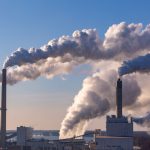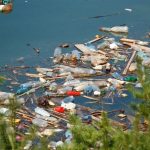Soil is a natural resource for which there is no substitute. Environmental historian Donald Worster reminds us that fertilizers are not a substitute for fertile soil. Soil can not be manufactured with a tank of chemicals. Soil is formed from the parent material by physical and chemical weathering of rocks. Climate and time are also important in the development of soils. Extremely dry or cold climates develop soils very slowly while humid and warm climates develop them more rapidly. It is a thin covering over the land consisting of a mixture of minerals, organic material, living organisms, air and water that together support the growth of plant life. The organic portion, which is derived from the decayed remains of plants and animals, is concentrated in the dark uppermost “top soil”. The inorganic portion, which is made up of rock fragments, is formed over thousands of years by physical and chemical weathering of bedrock. We may enhance the soil by helping its processes along, but we can never recreate what we destroy. Soil pollution is the introduction of substances, biological organisms, or energy into the soil, resulting in a change of the soil quality, which is likely to affect the normal use of the soil or endangering public health and the living environment.
Causes of Soil Pollution
a. Erosion: Soil erosion can be defined as the movement of surface litter and topsoil from one place to another. It is a natural process often caused by wind and flowing water, accelerated by human activities such as farming, construction, overgrazing by livestock, burning of grass cover and deforestation.
b. Soil contaminants are spilled onto the surface through many different activities. Most of these are the result of accidents involving the vehicles that are transporting waste material from the site at which it originated to the site at which it is to be deposited. Others involve accidents involving vehicles (automobiles, trucks and airplanes) not transporting wastes, but carrying materials, including fuel, that when spilled contaminate the soil. When any liquid pollutant is on or just below the ground the surface for any period of time, one of these could happen to it, if it is not cleaned up first.
c. Pollutant might be washed away by precipitation, causing little or no harm to the ground on which it is found (however, pollutants will simply accumulate somewhere else).The pollutant, if volatile, could evaporate, again causing little harm to the soil (however, not a solution to the bigger pollution problem, as it might become a source of air pollution)
d. Excess use of fertilizers and pesticides: Pollutant could infiltrate through the unsaturated soil, same way ground water. Agricultural practices including the use of agriculture chemicals is primary sources of pollution on or near the ground surface. Most agricultural chemicals are water soluble, nitrates and phosphates that are applied to fields, lawn and gardens to stimulate the growth of crops, gross and flowers. Farmers generally use fertilizers to correct soil deficiency. Mixed fertilizers often contain ammonium nitrate, phosphorus and potassium.
e. Excess use of irrigation water
KINDS OF SOIL POLLUTANTS
SOIL POLLUTANTS
PESTICIDES &
FERTILISERS
HEAVY METALS &
INORGANIC / ORGANIC SOIL POLLUTION
EXCESS SALT EXCESS WATER SOIL EROSSION
Effects of Soil Pollution
a) Food shortage: The foremost effect of loosing top soil is causing water pollution and reduced food production leading to food shortage. With population growth, it becomes more critical.
b) Desertification: Continuous exposure of eroded soil to sun for longer periods
may transform the land into sandy and rocky in nature. These are symptoms of
desertification rendering the soil unsuitable for cultivation.
c) Decrease in the extent of agricultural land
d) Top soil which is washed away also contributes water pollution by clogging of lakes, and increasing turbidity of water, ultimately leading to loss of aquatic life.
e) Sedimentation is reservoirs reduces the storage capacity inform causes reduction in command area.
f) Excess use of irrigation leads to waterlogging and soil salinisation.
g) Fertilizer run off leads to the eutrophication of waterways.
Control measures
a) Proper soil conservation measures to minimize the loss of top soil
b) INM, IPM, using bio pesticides and integrated environment friendly agriculture to reduce pesticides or fertilizers.
c) Appropriate water management practices in agriculture
d) Keeping the soil surface covered with crop residues or crop cover natural husking
e) Planting trees as a part of afforestation/ shelter belts/wind breakers
f) Cleaning up of polluted soil
Soil pollution information needed to clean up materials added to soil include the following:
1) Kind of material—organic or inorganic—is the material biodegradable, is the material dangerous to animals and humans.
2) C: N ratio of the pollutant material.
3) Nature of soil
4) Growing conditions for the soil organisms
5) How long as the material been on the site
6) Immediate danger to people and the environment.
One of the techniques for cleaning polluted soils is bioremediation
Bioremediation can be defined as any process that uses microorganisms, fungi, green plants or their enzymes to return the natural environment altered by contaminants to its original condition. Bioremediation may be employed to attack specific soil contaminants, such as degradation of chlorinated hydrocarbons by bacteria. Generally requires a mechanism for stimulating and maintaining the activity of the microorganisms, e.g., addition of an electron acceptor (oxygen, nitrate); nutrients (nitrogen, phosphorus); and an energy source (carbon). An example of a more general approach is the cleanup of oil spills by the addition of nitrate and/or sulfate fertilisers to facilitate the decomposition of crude oil by indigenous or exogenous bacteria. Naturally occurring bioremediation and phytoremediation have been used for centuries. For example, desalination of agricultural land by phytoextraction has a long tradition. Bioremediation technologies can be generally classified as in situ or ex situ. In situ bioremediation involves treating the contaminated material at the site. Ex situ involves the removal of the contaminated material to be treated elsewhere.
Conditions that favor Bioremediation include the following:
• Temperature favorable for organisms
• Availability of water
• Availability of nutrients(N,P,K)
• C:N ratio of the contaminant material
• Availability of oxygen in sufficient quantity in the soil
Some examples of bioremediation technologies are bioventing (injection of
air/nutrients into unsaturated zone), land farming, bioreactor, composting,
bioaugmentation (inoculation of soil with microbes), rhizofiltration, and biostimulation (stimulation of biological activity) and biosparging (injection of air/nutrients into unsaturated and saturated zone).
Not all contaminants, however, are easily treated by bioremediation using
microorganisms. For example, heavy metals such as cadmium and lead are not readily absorbed or captured by organisms. The assimilation of metals such as mercury into the food chain may worsen matters. Phytoremediation is useful in these circumstances, because natural plants or transgenic plants are able to bioaccumulate these toxins in their above-ground parts, which are then harvested for removal. The heavy metals in the harvested biomass may be further concentrated by incineration or even recycled for industrial use.


